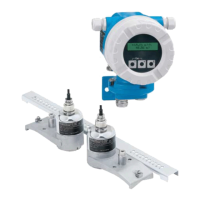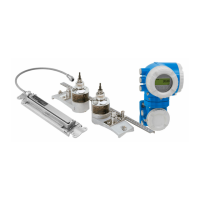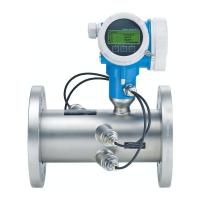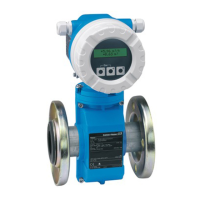4 Wiring PROline Prosonic Flow 93 PROFIBUS-DP/-PA
42 Endress+Hauser
Spurs (PROFIBUS-DP)
Note the following points:
Length of spurs < 6.6 m (at a max. of 1.5 MBit/s)
At transmission rates >1.5 MBit/s, spurs should not be used.
The line between the cable connector and the bus driver in the field device is called
a spur. Our experience with the systems, indicates that you should be quite careful
with the length of the spurs when planning your project. Therefore, we recommend
that you do not attempt to utilise the full theoretical maximum total combined length of
6.6 m for all spurs at 1.5 MBit/s. The order of the respective field devices makes more
of a difference in this case. We recommend that you avoid using spurs at transmission
rates
>1,5 MBit/s.
If you must use spurs, do not install terminating resistors on them.
Shielding and grounding (PROFIBUS-DP/-PA)
When planning the shielding and grounding for a fieldbus system, there are three
important points to consider:
Electromagnetic compatibility (EMC)
Explosion protection
Safety of the personnel
To ensure the optimum electromagnetic compatibility of systems, it is important that the
system components and above all the cables, which connect the components, are
shielded and that no portion of the system is unshielded.
Ideally, the cable shields will be connected to the field devices' housings, which are
usually metal. Since these housings are generally connected to the protective earth, the
shield of the bus cable will thus be grounded many times.
This approach, which provides the best electromagnetic compatibility and personnel
safety, can be used without restriction in systems with good potential equalisation.
In the case of systems without potential equalisation, a mains frequency (50 Hz)
equalising current can flow between two grounding points which, in unfavorable cases,
e.g. when it exceeds the permissible shield current, may destroy the cable.
To suppress the low frequency equalising currents on systems without potential
equalisation, it is therefore recommended to connect the cable shield directly to the
building ground (or protective earth) at one end only and to use capacitive coupling to
connect it to all other grounding points.
Setting the terminating resistors
Since mismatches in the impedance result in signal reflections on the line and can thus
lead to communication errors, it is important to terminate the lines properly.
#
Warning!
Risk of electric shock. Exposed components carry dangerous voltages. Make sure that
the power supply is switched off before you remove the cover of the electronics
compartment.
The terminator switches are located on the I/O board (see Fig. 46).
1. Remove the screws and open the housing cover (1).
2. Remove the screws securing the electronics module (2). Then push up electronics
module and pull it as far as possible out of the wall-mount housing.
3. Unplug ribbon cable connector (3) of the display module.
4. Remove the cover (4) from the electronics compartment by loosening the screws.
5. Removing the I/O board:
Insert a thin pin into the opening provided (5) and pull the board out of the holder.

